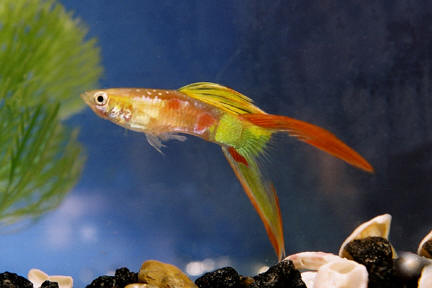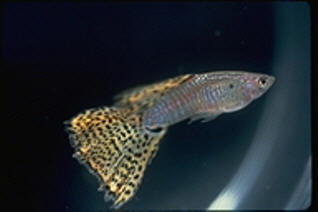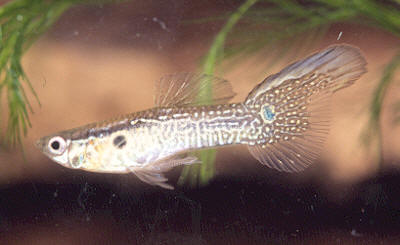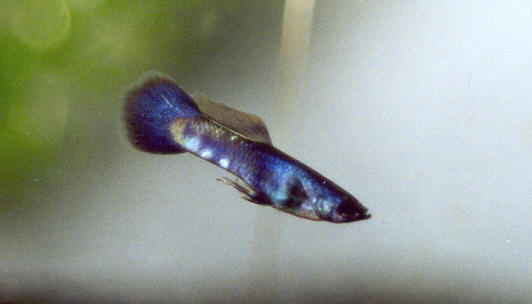| Data Sheet |
| |
| Scientific name: | Poecilia Reticulata | |
| Family: | Poeciliidae | |
| Origin: | Central America to Brazil | |
| Adult Size: | 2.5 inches (6 cm) | |
| Social: | Peaceful | |
| Lifespan: | 2-4 years | |
| Tank Level: | Top, Mid dweller | |
| Minimum Tank Size: | 5 gallons | |
| Diet: | Omnivore, eats a variety of foods | |
| Breeding: | Lifebearer | |
| Care: | Easy | |
| Ideal pH: | 7.0 - 8.5 | |
| Temperature: | 64-82 F (18-28 C) | |
| Sexing: | Males have longer, more colourful finnage and are smaller than females, which tend to be dull coloured. However, the most definitive feature in males is the gonopodium - a stick-like modified anal fin (used in breeding), instead of the normal rounded anal fin in females. |
|
| Breeding: | An easily bred and prolific fish. It is advisable to keep 2-3 females per male to reduce stress on specific females from the male. Around 30 young are normally produced. | |
| | Description:The female guppy is drab brown to grey in colour. The much smaller male naturally has a colourful caudal fin (tailfin), showing wide variety in the wild, depending on where the stock comes from. These colourful variations have been considerably enhanced in shape and colour by selective breeding. Habitat/Care:An easily cared for fish that does well in all types of community aquaria. Give them a fairly large tank with live plants and open swimming areas, avoid too much driftwood as a rule the livebearers do not like acidic water. Although not a schooling fish they benefit by being kept with a large number of their own kind. Temperature range from sixty-eight to eighty-seven degrees, water with a pH of 7 to 8.5 and hard to medium hard. You must provide a fairly large tank if you want their finage to develop to its potential. Cultivated varieties with very large fins should be kept singly. Guppies will except all types of flake food and small live food. Mixing with other fishes:Guppies are peaceful and mix well with any other PEACEFUL SMALL fishes. Larger fishes may eat guppies up. Diet:These fish like a varied diet of flake food. They readily take live food such as bloodworms, tubifex worms and glassworms, as well as live daphnia. Breeding:Male guppies are forever courting. If a female remains stationary and her partner contacts her vent with his gonopodium, she is fertilized. The sperm is preserved in the female's oviduct, and so even after males are removed, a female is capable of having six or more broods. Gestation averages a month but can be much longer, depending on the time of year, health of the female, and conditions in the tank. |
DiseaseIf you keep your water clean and do not overcrowd your fish, disease will not be a problem. The most common ailments and their treatment are listed below. | |
Photo Galley
Got a photo? Contact me.
 tuxedo guppy |  glass guppy |  mosaic and cobra guppy |
 double swordtail guppy |  ribbon guppy |  swallow guppy |
 golden guppy |  guppy calico lyre tail |  rainbow guppy |
 snakeskin |  triangle tail\ delta tail |  Top tail |
Links to other awesome Guppy sites:
1.http://www.guppy-fish.com/guppy/tuxedo.html a good collection of guppy for sale. Love the photo galley and information here.
2. http://www.world-guppy.de/ an awesome photo galley.
3. http://www.asianaquariums.com/guppypic.htm another lovely photo galley.
4. http://hem.passagen.se/mikeno/english/esfo.htm Superb! This site got my vote
for the best guppy photo galley! Must see!
References Cited:
1. AquariaCentral, Guppy [Online], Available, http://www.aquariacentral.com/fishinfo/fresh/guppy.htm
2. International Fancy Guppy Association, [Online], available http://www.ifga.org/beginners/beginners_corner.htm
3. Guppy [Online], Available, http://en.wikipedia.org/wiki/Guppy
4. The Aquarium Fish Handbook (2001) by David Goodwin. Publisher: D&S books, England.
5. Poecilia Reticulata [Online], Available, http://badmanstropicalfish.com/profiles/profile15.html
6. Fish Pic & Info: Guppy [Online], Available, http://www.angelfire.com/az3/tropicalaquarium/guppy.htm































No comments:
Post a Comment